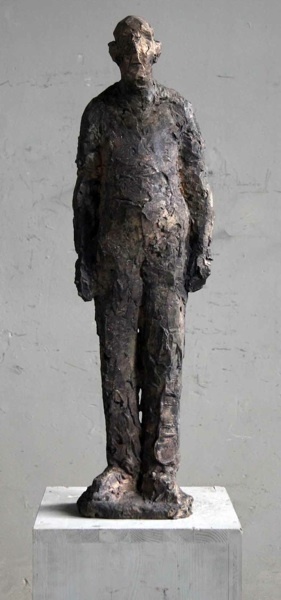Hans Josephsohn
Though Josephsohn worked often with models, his sculptures are not portraits but rather studies of the human figure as formal composition. He was unconcerned with difference, with the particularities of personhood, looking instead for humanity’s image. Indeed, permanence was among Josephsohn’s most apparent concerns. “My figures must be enduring in their expression, in their stance,” Josephsohn said, “a narrative gesture is out of the question.” Such is Untitled, stoic and static in form. It evokes the Greek Kouros in posture, yet has nothing of their athletic beauty, their youthful self-assurance. The figure simply is – a form without allusions to greatness. Still, it is imbued with an inherited weight. The human, after all, is art’s most lasting subject, from pre-history to the present.
b.1920, Kaliningrad; d.2012, Zürich
“If you take anything away,” Hans Josephsohn said of his monolithic sculptures, “nothing at all remains. The figure consists solely of relationships… You remove a piece and nothing is left.” For all the apparent solidity of Josephsohn’s work, it has about it a formal uncertainty, its figuration vulnerable always to abstraction. Such pictorial precarity is not uncommon in much post-war European art, together gathered under the loose title of existentialism, which gives expression to the ravages of the Second World War and the loss of faith and meaning that attended it. The war perhaps also accounts for the muteness of Josephsohn’s figures – the artist himself was voiceless under Nazi persecution, fleeing his native East Prussia first for Italy and then to Switzerland. The human, Josephsohn’s sculpted figures suggest, is both frail and enduring, easily broken and lasting. Though modern in mood, his works appear as ancient artefacts, figures from antiquity, archetypal and weathered by history. Josephsohn’s sculptures, reduced to those details most essential to their form, maintain a tactile complexity, each made from accumulated plaster applied in mottled layers. Later cast in brass and left unpainted, they appear as relics made from rough-cut stones.
